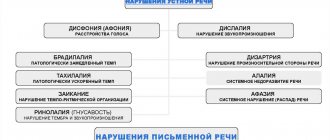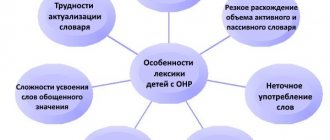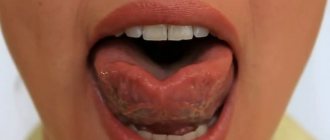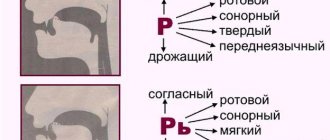Article:
First of all, it should be noted that to denote distorted pronunciation of sounds, international terms are used, derived from the names of the letters of the Greek alphabet using the suffix “-ism”.
They are distinguished: sigmatism, rotacism, lambdacism, iotacism, gammacism, hitism. In cases where a replacement of sound is noted, the prefix “-para” is added to the name of the defect - parasigmatism, pararotacism, etc. (L.S. Volkova, S.N. Shakhovskaya, 2002, p. 97). Sigmatismus, a speech disorder involving incorrect pronunciation of hissing and whistling sounds. In children suffering from sigmatism, there is a violation of the pronunciation of sounds [s], [z], [ts] and [sh], [zh], [h], [sch]. Sigmatism is one of the very common types of incorrect sound pronunciation. There is a fairly large number of variants of both purely phonetic sigmatism (interdental, lateral, nasal, labiodental) and parasigmatism (dental, whistling, hissing). This suggests that the pronunciation of whistling and hissing sounds is quite difficult.
Various defects in the pronunciation of the sound [r] are combined under the name rhotacism. Due to the great complexity of articulatory work, and in particular the tongue (all muscles of the tongue are involved), many types of rotacism are observed. For example, speech therapist A.Ya. Jaunberzin registered 28 variants. The most common will be the following: absence of [r] (complete absence of sound or the sound of a vowel instead), nasal pronunciation, throat pronunciation (velar or uvular), single-stress, voiceless, bilabial [r]. There are many options and pararotacism: replacements - r-d, r-y, r-l, r-l, r-n, r-g, r-s.
All defects in the pronunciation of the sound [l] are combined under the name lambdacism. There are three types of lambdacism: absence of sound [l] or oversound of a vowel, bilabial or labial-dental pronunciation of the sound [l], nasal pronunciation - l-ng; paralambdacisms: l-d, l-l' (with varying degrees of softening), l-r, l-v, l-n, l-s or u.
Defects in the pronunciation of the semivowel sound [th] are called iotacism. The sound [й] is used in Russian in two meanings: as a non-syllabic sound (edge, tea, war) and as a syllabic sound included in the pronunciation of iotated vowels i, e, yu, e at the beginning of a syllable. These two meanings of the sound [th] receive slightly different expressions due to defects in the pronunciation of the sound. Pronunciation defects: 1) the sound [th] is not pronounced at all (moy-mo; yama-ama); 2) [th] is replaced by [i] (my - mine; yama - iama); 3) [th] is replaced by [l] (chai-chal; yama.-lyamo).
Defects in the pronunciation of palatal sounds are called kappacism - sounds k and k', gammacism - sounds g and g', hitism - sounds x and x' (R.E. Levina, 1968).
In addition to those described above, speech therapy literature identifies disorders in the softening and voicing of sounds.
In the pronunciation of consonants that have a voiced and a voiceless pair, voicing defects are observed. Three types of voicing disorders are observed: a) complete absence of voiced consonant sounds in speech, i.e. their constant replacement with paired deaf ones; b) insufficient voicing; c) insufficient stunning. All three cases relate to paralalia and, as a rule, are reflected in writing. Researchers note that devoicing of voiced consonants is observed more often than voicing of deaf consonants.
Among softening defects, three options are also observed: a) complete absence of soft consonant sounds in speech, i.e. their constant replacement with paired hard sounds; b) excessive softening c) violation of differentiation between hard and soft sounds, i.e. Along with the correct pronunciation of hard and soft consonants, deviations are observed in both directions.
Having examined the speech therapy classification of sound pronunciation disorders, it must also be said that in different children, incorrect pronunciation can either concern only one group of sounds (voiced, velar or sibilant, etc.), and then it is called a simple, partial, monomorphic sound pronunciation defect, or cover many groups of sounds (at the same time the same child can suffer from rhotacism, sigmatism and voicing defects, etc.), then the defect is called complex diffuse, polymorphic (L.S. Volkova, S.N. Shakhovskaya, 2002).
Naturally, the more complex the indicated defect, the more the euphony and intelligibility of speech suffers. The more complex the sound, the later and more difficult it is for the child to establish its correct pronunciation and the more diverse the pronunciation defects will be.
Many authors note that in some cases children correctly use sound in isolation, in syllables, and sometimes in words and in reflected speech, but do not use it in independent speech (L.S. Volkova, S.N. Shakhovskaya, 2002, p.97 ). Similar phenomena are noted in the works of O.V. Pravdina (1973), K.P. Beckera, M. Sovaka (1981), M.E. Khvattseva (1996), etc. These data indicate that children’s pronunciation skills correlate with the degree of complexity of the type of speech activity.
O.V. Pravdina (1973) distinguishes three levels of impaired pronunciation: inability to correctly pronounce a sound or group of sounds; incorrect pronunciation of them in speech when correctly pronounced in isolation or in light words; insufficient differentiation (mixing) of two sounds that are similar in sound or articulation with the ability to correctly pronounce both sounds. The identified levels reflect the stages of sound acquisition in the process of child development, identified by A.N. Gvozdev (1961). These data indicate that a child with impaired pronunciation goes through the same stages of sound acquisition as a normal child, but at some stage he may be delayed or stop.
As T.B. points out. Filicheva, N.A. Cheveleva, G.V. Chirkina (1989), in the process of normal development of a child’s auditory function, a number of stages can be distinguished: a) in the first hours after birth, the child has a simple reaction to sound (like unconditioned reflexes), when in response to a loud knock, blow, noises occur changes in sucking movements, pulsation, breathing; b) at the 3rd month. the child develops the ability to distinguish sounds by pitch and timbre; c) at 10 - 11 months. the ability to distinguish words and phrases by their intonation and rhythmic coloring is formed; d) during the period of further speech formation, thanks to the gradual improvement of auditory function, the perception of the sound composition of speech improves, and the ability to distinguish by ear all phonemes of the native language is formed. This is one of the necessary conditions for the successful development of children's speech.
At the same time, R.M. Boskis (1988, p. 30) writes: “The auditory analyzer, unlike other analyzers, plays a decisive role in the development and functioning of auditory speech. Therefore, the most characteristic specific deviations in the development of a child with a defect in the auditory analyzer are associated with the characteristics of his speech development.” The author points out that it is also important to keep in mind that hearing and speech are very closely related. Not only hearing damage leads to deviations in the development of auditory speech, but also the functioning of the auditory analyzer is closely dependent on the level of speech development. The richer the speech, the easier it is to use an inferior auditory analyzer to perceive it.
T.B. Filicheva, N.A. Cheveleva, G.V. Chirkina (1989, p. 167) note that characteristic deficiencies in pronunciation in children with hearing impairment are the following: a) confusion of sounds, often voiced with deaf, hissing with whistling, hard with soft; b) there is often a replacement of some sounds with others, for example, whistling sounds with plosives, etc.; c) softening defects (“auntie” instead of grandfather, “tota” instead of auntie); voicing defects; d) the absence of one of the component sounds due to the late formation of affricates; e) distorted pronunciation of sounds. Along with this, hearing-impaired children do not master the pronunciation of sounds that are difficult to articulate (r, l, ch, sch, ts, etc.). According to these authors, the speech of the hearing impaired is characterized by general blurriness and poor intonation. The voice of such children is dull and poorly modulated. The pace of speech is usually slow.
As L.S. writes Volkova and S.N. Shakhovskaya (2002, p. 491), “auditory differentiation of speech sounds in the hearing impaired suffers primarily due to the limitation of the range of sound frequencies perceived by them. In addition, in children there is a secondary underdevelopment of analytical-synthetic activity in the central section of the speech-auditory analyzer, caused by the “poor quality” of auditory stimuli coming from the periphery (complete impossibility of perceiving sounds by ear or not perceiving all their formants).”
L.V. Neiman and V.I. Beltyukov (1958, p. 84) note that children with degree I hearing loss can distinguish no more than 75% of consonants pronounced in a voice of conversational volume near the auricle itself. At the same time, already at a distance of 0.5 m from the ear, the ability to distinguish consonants is reduced to 60%, and at a distance of 2 m - even to 40%. The perception of coherent speech under these conditions is possible only because children who are fully proficient in speech rely on their existing holistic images of words and phrases, which allows them to infer (often erroneously) the missing links. If the child does not speak detailed speech, then such speculation turns out to be impossible. Therefore, children with the same degree of hearing loss, but with different levels of speech development, recognize speech sounds differently. For this reason, even with the same degree of hearing loss, the state of auditory differentiation of speech sounds in students of the second department of the school for the hearing impaired is generally much worse than in students of the first department.
However, even in the first department of the school for the hearing impaired, according to research by L.G. Paramonova (1981), over 78% of high school students do not differentiate by ear from 4 to 45 pairs of consonant sounds. The auditory differentiation of sibilants s and c in words like light - color is especially difficult. According to the study by L.V. Neumann (1961, p. 239), for hearing-impaired students of the first department, the perception of whistling and hissing sounds also poses a difficulty. In addition to the purely acoustic features mentioned, it is also reflected in the fact that these sounds begin to differentiate in pronunciation relatively late. Here we observe the inhibitory influence of the speech motor analyzer on the auditory speech analyzer. Auditory differentiation of other phonetic groups of consonant sounds for hearing-impaired students of the first department presents significantly less difficulties.
L.V. Neumann (1961) and L.G. Paramonova (1981) also provide data on impaired sound pronunciation in hearing-impaired schoolchildren. They note that sound pronunciation is especially impaired in hard-of-hearing students of Division II, not only of consonants, but even of vowels. However, in the first department of schools for the hearing impaired, there are sound pronunciation defects even in high school. As with the hard-of-hearing group II, cases of polymorphic disturbances in sound pronunciation prevail here, covering many phonetic groups of sounds (on average, there are 11 defectively pronounced sounds for each student). Even the hearing impaired in the first department suffers from the pronunciation of not only articulatory complex consonants, but also relatively articulatory simple consonants (labial, labiodental, anterior lingual, etc., d, n, etc.). The basis of their disorders is the inferiority of the work of not only the speech-auditory, but also the speech-motor analyzer.
That is, as can be seen, all authors indicate that the formation of sound pronunciation in the hearing impaired proceeds with significant deviations from the norm due to the inferiority of the speech-auditory analyzer, which is not able to carry out its “leading role” to the required extent in relation to the speech-motor analyzer. Unable to perceive a particular speech sound by ear or differentiate it from similar sounds, the child cannot independently master its correct articulation. Children who are hard of hearing may have disturbances in the structure and functioning of the speech motor analyzer, which may also cause them to have defective pronunciation of sounds.
The state of auditory differentiation of speech sounds in the hearing impaired of the first department is such that it cannot ensure that children master full sound pronunciation, and subsequently, writing.
Thus, we can distinguish three main forms of sound pronunciation impairment in hearing-impaired schoolchildren.
1. In case of insufficiency of the sensory part of the speech apparatus, i.e. defective activity of the auditory analyzer, characterized by the replacement of some speech sounds with others (“suba” instead of shuba). Less often than replacements, distorted pronunciation of sounds is observed, associated with the impossibility of their clear auditory differentiation from other sounds or with the complete impossibility of perceiving them by ear due to the partial loss of the corresponding sound frequencies. Deviations from the norm in the structure or functioning of the motor part of the speech apparatus are usually not observed in sensory forms of sound pronunciation impairment. Sound substitutions present in a child’s oral speech are usually reflected in writing in the form of corresponding letter substitutions. In lower grades of hearing-impaired schools, such forms of sound pronunciation disorders usually come to the fore.
2. Due to insufficiency of the motor part of the speech apparatus, i.e. deviations from the norm in the structure or functioning of the articulatory organs, violations are usually expressed in the distorted sound of sounds (burry r, interdental or lateral s, etc.).
3. Mixed forms of sound pronunciation disorders, caused simultaneously by both sensory and motor insufficiency. In these cases, in the same child, defects in the pronunciation of some sounds are associated with the impossibility of their auditory differentiation from similar phonemes (replacement of c with s), while defects in the pronunciation of other sounds are associated with deviations from the norm in the structure or functioning of the articulatory apparatus (for example, burry r with a short hypoglossal ligament or interdental with paretic muscles of the tip of the tongue). Sometimes defects in the pronunciation of the same sounds in a child have both motor and sensory causes. This occurs in cases where the inability to perform the articulatory movements necessary to pronounce a given sound is combined with the impossibility of auditory differentiation from sounds that are acoustically close to it (L.S. Volkova, S.N. Shakhovskaya, 2002).
At the same time, L.G. Paramonova (1981, p.6) writes that “in hearing-impaired children, mixed forms of sound pronunciation disorders are predominant.”
It should also be noted that the child’s capabilities in preserving auditory representations of speech and the features of this process in conditions of hearing impairment can be examined based on the material of his writing, which reflects his auditory-speech representations. L.V. Korshunova (1972) gives a number of typical violations of the phonetic composition of words found in the writing of hearing-impaired children: 1) expressed in the replacement of a voiced consonant with a deaf one (more - poland, books - books); in the replacement of deaf - voiced (boots - sabogs); 2) expressed in various kinds of replacements of a soft consonant with a hard one and a hard consonant with a soft one (airplanes - airplanes, fork - vylka, again - honey mushrooms, pencil case - pencil case); 3) violations of the sound composition of words, including hissing and affricates (brush - shetka, matches - spishki, prey - prey, hare - hare); 4) violation in the writing of words that contain compounds of the vowel sound “and” (bunnies - zachiki, leika - leika, hedgehog - ezh, dress - pay); 5) various disorders, expressed in complete or partial distortion of the sound composition of the word and violation of the syllabic structure (today - sevoli, healthy - zarov, catch - ovut, remove - upira).
The reason that makes it difficult for a late-deaf child to learn to write and causes these disturbances is L.V. Korshunova considers the special conditions for the activity of the auditory analyzer. Auditory representations of words are not supported by actual auditory perceptions. This circumstance leads to a change in the characteristics of auditory representations of speech and determines the uniqueness of analytical activity in the writing process.
Thus, proper hearing is crucial for the development of a child’s speech. And the quality of the phonetic design of the speech of a hearing-impaired child, as noted by F.F. Rau (1981), it depends to what extent it is understandable to others and to what extent it can serve as a basis for language proficiency and serve as a tool of thinking. For the purposes of communication with others, it is important that the speech of a child with hearing loss is phonetically intelligible. But for the true development of oral speech, and in particular its phonetic-phonemic side, a hearing impaired person needs special training. Practice has long proven that as a result of training, children with hearing impairment are able to master verbal speech not only in a more accessible written and dactylic form, but also in the form of the spoken word. References: 1) Becker K.P., Sovak M. Speech therapy. - M.: Medicine, 1981. - 288 p. 2) Beltyukov V.I., Neiman L.V. Perception of speech sounds in normal and impaired hearing. - M.: APN RSFSR, 1958. - 51 p. 3) Boskis PM To the teacher about children with hearing impairments. - M.: Education, 1988. - P.26-48. 4) Gvozdev A.N. Issues in studying children's speech. - M.: APN RSFSR, 1961. - 131 p. 5) Korshunova L.V. Writing impairment in late-deafened children. // Defectology. No. 4. 1972. - P.41-45. 6) Speech therapy. 3rd ed., revised. and additional / Edited by Volkova L.S., Shakhovskaya S.N. - M.: Vlados, 2002. - 680 p. 7) Neiman L.V. Hearing function in hard of hearing and deaf-mute children. - M. Publishing house of the Academy of Pedagogical Sciences of the RSFSR, 1961. - 359 p. Fundamentals of the theory and practice of speech therapy. / Ed. R.E. Levina. - M.: Education, 1968. - 367 p. 9) Paramonova L.G. Guidelines for identifying and correcting defects in sound pronunciation and related writing disorders in hearing-impaired students of the first department. — L.: Len. Department of Science, 1981. - P.6-10. 10) Pravdina O.V. Speech therapy. Textbook manual for defectologist students. fact-tov ped. Inst. Ed. 2nd, add. and processed - M.: Education, 1973. - 272 p. 11) Rau F.F. Formation of oral speech in deaf children. / Ed. and with a preface. T.A. Vlasova and others - M.: Pedagogika, 1981. - 168 p. 12) Filicheva T.B., Cheveleva N.A., Chirkina G.V. Basics of speech therapy: Textbook. - M.: Education, 1989. - P.165-172. 13) Khvattsev M.E. Speech therapy. - M.: Aquarium, St. Petersburg: Delta, 1996. - 384 p.
And the quality of the phonetic design of the speech of a hearing-impaired child, as noted by F.F. Rau (1981), it depends to what extent it is understandable to others and to what extent it can serve as a basis for language proficiency and serve as a tool of thinking. For the purposes of communication with others, it is important that the speech of a child with hearing loss is phonetically intelligible. But for the true development of oral speech, and in particular its phonetic-phonemic side, a hearing impaired person needs special training. Practice has long proven that as a result of training, children with hearing impairment are able to master verbal speech not only in a more accessible written and dactylic form, but also in the form of the spoken word. References: 1) Becker K.P., Sovak M. Speech therapy. - M.: Medicine, 1981. - 288 p. 2) Beltyukov V.I., Neiman L.V. Perception of speech sounds in normal and impaired hearing. - M.: APN RSFSR, 1958. - 51 p. 3) Boskis PM To the teacher about children with hearing impairments. - M.: Education, 1988. - P.26-48. 4) Gvozdev A.N. Issues in studying children's speech. - M.: APN RSFSR, 1961. - 131 p. 5) Korshunova L.V. Writing impairment in late-deafened children. // Defectology. No. 4. 1972. - P.41-45. 6) Speech therapy. 3rd ed., revised. and additional / Edited by Volkova L.S., Shakhovskaya S.N. - M.: Vlados, 2002. - 680 p. 7) Neiman L.V. Hearing function in hard of hearing and deaf-mute children. - M. Publishing house of the Academy of Pedagogical Sciences of the RSFSR, 1961. - 359 p. Fundamentals of the theory and practice of speech therapy. / Ed. R.E. Levina. - M.: Education, 1968. - 367 p. 9) Paramonova L.G. Guidelines for identifying and correcting defects in sound pronunciation and related writing disorders in hearing-impaired students of the first department. — L.: Len. Department of Science, 1981. - P.6-10. 10) Pravdina O.V. Speech therapy. Textbook manual for defectologist students. fact-tov ped. Inst. Ed. 2nd, add. and processed - M.: Education, 1973. - 272 p. 11) Rau F.F. Formation of oral speech in deaf children. / Ed. and with a preface. T.A. Vlasova and others - M.: Pedagogika, 1981. - 168 p. 12) Filicheva T.B., Cheveleva N.A., Chirkina G.V. Basics of speech therapy: Textbook. - M.: Education, 1989. - P.165-172. 13) Khvattsev M.E. Speech therapy. - M.: Aquarium, St. Petersburg: Delta, 1996. - 384 p.
Myofunctional disorders. Interdental sigmatism in a preschool setting
Ekaterina Sergienko
Myofunctional disorders. Interdental sigmatism in a preschool setting
The distortion of whistling and hissing sounds is called sigmatism . Interdental , subdental and labial-dental sigmatism is observed with :
- open bite;
- crossbite;
- poor tongue mobility (dysarthria)
;
- mouth breathing (adenoids)
;
-swallowing with the tongue resting on the lower jaw (the so-called infantile type of swallowing)
.
If a child exhibits these indicators, this indicates that there are myofunctional disorders . Myofunctional disorders - a decrease or increase in the normal tone of the masticatory and facial muscles, arising from dysfunctions of the dental system (breathing, swallowing, chewing, speech)
In case of malocclusion , it is necessary to refer parents and children to an orthodontist.
The cause of the disorders is often anomalies in the development of the jaw and tongue (in practice, macroglossia is quite rare)
.
Another reason may be adenoids (the nose does not breathe and the mouth is open)
.
A child who breathes through the mouth for a long time develops an adenoid type of face - an elongated shape and a stupid expression due to the open mouth. Difficulty breathing through the nose can lead to increased activity of the muscles of the alar muscles of the nose, the orbicularis oris muscle and the genioglossus muscle. This in turn entails protrusion of the tongue (
interdental pronunciation ) and opening of the mouth to facilitate breathing.
The cause of interdental pronunciation may be dysarthria. Minimal dysarthric disorders (erased dysarthria)
– speech pathology, defined in disorders of the prosodic and phonetic components of the speech functional system.
The disorder is caused by insufficient innervation of the articulatory apparatus.
In modern speech therapy, much attention is paid to the correction of erased dysarthria, which is due to the widespread prevalence of this disorder in children with deviations in speech development. Speech therapists often have to deal with difficulties not only in producing sounds, but also in introducing the given sounds into speech (the process of automation)
.
disorders are more common : the tongue is sluggish, cannot be held in the mouth, sometimes the picture is complemented by salivation (salivation)
.
Many specialists have spoken about the problem of dysarthria. There are pressing problems for speech therapists: the lack of diagnosis of speech disorders of the central nervous system by neurologists, the lack of treatment for children diagnosed with dysarthria.
within walking distance (a teacher or speech therapist may suspect a diagnosis of dysarthria when diagnosing a child).
Muscle hypotonia is directly related to central nervous system disorders .
Therefore, consultation with a neurologist is necessary. Many neurologists forget that speech is a manifestation of higher nervous activity, inherent only to humans; The duties of a neurologist should include examining the motor skills of the muscles of the face, tongue, hands, and coordination of the child’s movements. Dysarthria is a consequence of organic damage to the central nervous system, in which the motor mechanism of speech is disrupted. Interdental and labiodental sigmatism are most often a consequence of hypotension (decreased muscle tone)
. With hypotonia, the tongue is thin, spread out in the oral cavity; lips are flaccid and cannot close tightly. Because of this, the mouth is usually half-open, and hypersalivation may be expressed.
In practice, teachers and speech therapists try to do everything for the child. To overcome dysarthria we use traditional and non-traditional methods. Speech therapy work to overcome the erased form of dysarthria requires the mandatory participation of parents in the correction process. Since the defect of interdental and labial-dental sigmatism is persistent and, with improvement, often returns in the form of relapses, the joint work of parents and a teacher-speech therapist is undoubtedly necessary.
With interdental sigmatism, the functions of the oral muscles are impaired and the tone of the orbicularis oris muscle is weakened. We observe lethargy and passivity of the longitudinal muscles of the tongue. The tongue makes primitive movements only forward, beyond the front and lower teeth.
It is necessary to perform articulatory gymnastics daily. The speech therapist will select the necessary set of exercises based on the child’s articulation capabilities.
Tongue massage (speech therapy massage)
widely used in the correction
of interdental , subdental and labiodental sigmatism .
Rubbing, kneading, vibration and tapping, firm pressure, acupressure - these active types of speech therapy massage are especially effective. This requires specialist advice. Isotonic exercises (with elements of resistance)
very effective in working to overcome
interdental and labial-dental sigmatism , as they force the muscles of the tongue to work and tense.
With the help of the techniques described above, the child acquires kinesthetic self-control, begins to better feel the movements being performed (especially with the tongue, which helps overcome interdental , subdental and labial-dental sigmatism .
The timing of correction depends on the severity of the speech defect, age and individual characteristics of the child. Factors such as regularity of classes and participation of parents in correctional work are of great importance.
In case of myofunctional disorders, an interdisciplinary approach is necessary, therefore, in case of sigmatism to refer the child to a dentist - orthodontist. Overcoming interdental sigmatism must be preceded by eliminating open bite. To correct an open bite, pediatric orthodontists recommend using special vestibular plates - trainers - soft silicone myofunctional positioners that correct the position of the tongue and help normalize muscle balance.
Myofunctional disorders in children can be effectively corrected with early detection, as well as with competent interaction between a speech therapist, neurologist and dentist. This integrated approach ensures high stability of the results of speech therapy correction.







